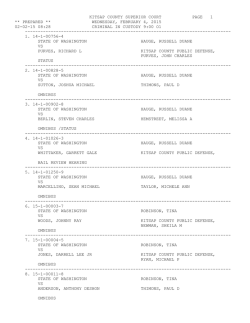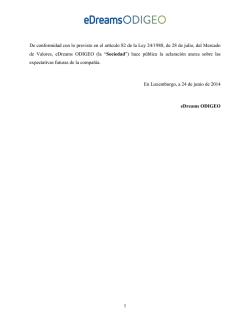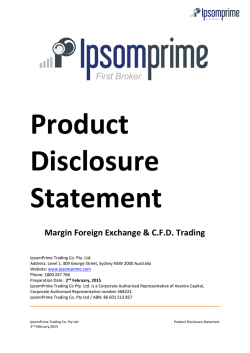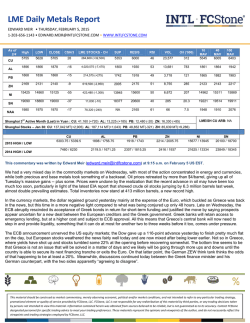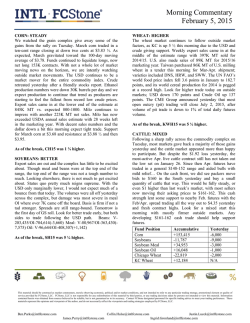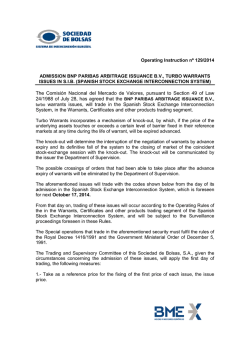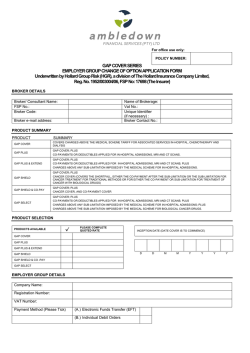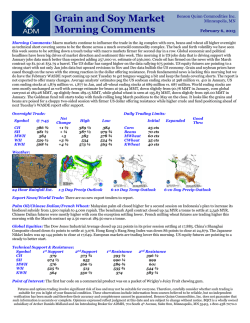
Omnibus Broker PDF Guide
Omnibus Brokers Getting Started Guide February 2016 © 2016 Interactive Brokers LLC. All Rights Reserved Any symbols displayed within these pages are for illustrative purposes only, and are not intended to portray any recommendation. 2 Contents Contents Getting Started as an IB Omnibus Broker i 1 Must Consider: 1 May Want to Consider: 2 Log In to Account Management 3 Failed Login Attempts 4 Automatic Logoff 4 Secure Login System 4 Client Accounts 7 Funding 9 Broker Funding Client Account Funding Trading 9 10 11 Subscribe to Market Data 11 Log in to TWS 13 Add Market Data 14 Trading 16 Real-time Activity Monitoring 18 View Account Balances 21 Real-time Margin Monitoring 22 Monitor Margin Requirements 23 Omnibus Brokers Getting Started Guide i Contents Try PM 23 Margin Warnings 24 View Available for Trading Values 24 View Market Value 25 View FX Portfolio Values 25 View Portfolio Values 26 The Right-Click Portfolio Menu 26 Reporting Activity Statements Customized Activity Statements 29 29 32 Third-Party Downloads 33 Trade Confirmations 34 Flex Queries 35 Margin Reports 35 Stress Test Report 36 Value at Risk Report 37 Broker Exception Reports 38 Client Summary Report 39 Client Revenue and Expense Summary 40 PortfolioAnalyst 41 Other Features 43 Opening a Paper Trading Account 43 Paper Trading Account Reset 45 Paper Trading Account Statements 45 Omnibus Brokers Getting Started Guide ii Contents White Branding for Brokers 46 Configuring OATS Settings for Client Accounts 47 Updating Your Broker Information 48 Customer Activity Monitor 49 Index Omnibus Brokers Getting Started Guide 51 iii (Undefined variable: General.Book) iv 1 Getting Started as an IB Omnibus Broker This Getting Started guide provides a comprehensive collection of the tasks you will want to complete as a new IB Omnibus Broker. In the Omnibus Broker account structure, all trades are placed by you on behalf of your clients, who are unknown to Interactive Brokers, your clients do not trade directly. Each trade must be marked with the appropriate open or close indicator, to ensure that the trades are placed into the correct long or short account. Please note that this guide is designed as a reference for new users, and comprises a very small subset of the information and trading features available to you through IB and the TWS. The guide assumes the following: That your account has been approved and funded. That you are the Broker master. That a Proprietary Account for Broker-Dealers was automatically created for your own personal trading during the application process. Must Consider: Understand how to log in to Account Management. Activate your Secure Login System device. Understand the process and timing of account funding, including: Fund the Master Account and the Proprietary Account for Broker-Dealers Fund Client Accounts Add and manage client accounts: Trade: Subscribe to Market Data Log in to TWS Add Market Data Lines Broker Trading Omnibus Brokers Getting Started Guide 1 Chapter 1 May Want to Consider: Use Real-time Activity Monitoring Familiarize yourself with activity statements and other features of our reporting system May Want to Consider: Open a Paper Trading Account Broker White Branding Configure OATS Settings for Client Accounts Update Your Broker Information Customer Activity Monitor Omnibus Brokers Getting Started Guide 2 2 Log In to Account Management There are two ways to access Account Management: Log in from the IB website. Access the home page from the Trader Workstation. To log in to Account Management from the IB website 1. From IB’s website, select Account Management from the Login dropdown list in the upper right corner. 2. Enter your IB Username and Password, and click Login. The Account Management home page opens. Omnibus Brokers Getting Started Guide 3 Chapter 2 Failed Login Attempts To access Account Management from Trader Workstation 1. Log in to Trader Workstation. 2. From the Account menu, select Account Management Home. The Account Management home page opens. For more information Failed Login Attempts Automatic Logoff Failed Login Attempts After ten failed login attempts in 24 hours, your Account Management login will be disabled. If this happens, contact Customer Service. Automatic Logoff If you are logged into Account Management and the system detects no activity for 30 minutes, your Account Management session will automatically expire and you will have to log back in. A message appears warning you that you will automatically be logged out without further activity. Once your session expires, another message appears informing you that your session has expired and you have been logged out. You must re-login to start a new Account Management session. Secure Login System Once your account is approved and funded, IB will mail you a Secure Login Device at the address you specified in your application. You will need to use this device anytime you log in to TWS or Account Management. This added level of security helps to ensure that your IB account information remains secure. Please note that your device must be activated before you can use it. Omnibus Brokers Getting Started Guide 4 Chapter 2 Secure Login System You have 14 days from the day we mail you your IB Security Device to activate the device in Account Management. After 14 days, you are required to use the device to log into Account Management and Trader Workstation. If you receive the device before 14 days, you can access Account Management and Trader Workstation without using the device until you activate it or until 14 days have passed. Once you activate the device, you must use it to log into Account Management and TWS. You can also choose to use IB Key, our digital security device, on your cell phone. For more information, see our Knowledge Base article. To activate your Secure Login Device 1. Login to Account Management. 2. Click Manage Account > Security > Secure Login System. 3. Follow the instructions on the screen to activate your security device. For more information To learn more about our Secure Login System, including detailed instructions on how to use each type of security device, see the Account Management Users’ Guide. Omnibus Brokers Getting Started Guide 5 (Undefined variable: General.Book) 6 3 Client Accounts As an Omnibus broker, you do not add client accounts. When your account is opened, two client, or sub, accounts, will automatically be created; one holds long positions and the other holds short positions. Omnibus Brokers Getting Started Guide 7 (Undefined variable: General.Book) 8 4 Funding Funding is an important part of the application process. Your broker account consists of multiple accounts at different levels, and can include multiple users who have permissions to manage one or multiple accounts. The Omnibus account consists of three separate accounts; The master account which is used to provide clients with customer service, marketing, a registration process, cashiering functions, trade entry, and individual client account record keeping and two client accounts, one to hold all long positions and the other to hold all short positions. All funds are deposited to the master account. Deposits can be made in a number of ways, including Wire, Check, ACATS, etc. In order to prevent any delays in an account's funding, it is important that you complete the funding information portion of the application. If we do not receive your client funds in 45 days from approval, the account will automatically be closed. This section includes the following topics: Master and Proprietary Account for Broker-Dealers Funding Client Account Funding For more information For specific details on Deposit Notifications, Transfers, and other funding issues, see the Funding Reference on our website. Broker Funding In an Omnibus Broker account, all deposits should be made to the master account. Omnibus Broker accounts do not have a PAB trading account. Omnibus Brokers Getting Started Guide 9 Chapter 4 Client Account Funding To deposit funds into your master account, log in to Account Management with your master account username and password, and then click Funding > Fund Transfers and initiate a deposit transaction. For more information For detailed instructions on depositing funds, see the Depositing Funds topic in the Funding chapter of the Account Management Users’ Guide. For specific details on Deposit Notifications, Transfers, and other funding issues, see the Funding Reference on our website. Client Account Funding Omnibus Brokers deposit all funds into the master account for trading. Use the Funding > Fund Transfers page in Account Management to transfer funds from the Master account to a client account. Deposits can be made in a number of ways, including Wire, Check, ACATS, etc. In order to prevent any delays in an account's funding, it is important that you complete the funding information portion of the application. If we do not receive your client funds in 45 days from approval, the account will automatically be closed. For more information For detailed instructions on depositing funds, see the Depositing Funds topic in the Funding chapter of the Account Management Users’ Guide. For detailed instructions on depositing funds, see the Funding Reference on our website. Omnibus Brokers Getting Started Guide 10 5 Trading The Trader Workstation (TWS) is a robust platform which allows access to a variety of powerful trading tools. Information about all of the tools which IB offers can be found on the Trader Workstation page of the IB web site. This section of the guide will focus on TWS basics and will show you how to: Subscribe to Market Data; Log in to TWS; Add Market Data Lines (ticker lines) to the TWS trading window; Trade for the long or short account; Monitor clients’ trade activity, positions and P&L, and account balances using our Real-time Activity Monitoring tools. For more information For complete information on Trader Workstation, see the Trader Workstation Users' Guide. Subscribe to Market Data Before you begin trading for your clients, you will want to subscribe to market data through Account Management. Although you can trade without data, IB does not recommend it. To subscribe to Market Data 1. Log in to Account Management. 2. Click Manage Account > Trade Configuration > Market Data. Omnibus Brokers Getting Started Guide 11 Chapter 5 Subscribe to Market Data Your current market data subscriber status (Professional or Non-Professional) is displayed in the page title. Market data subscriptions are organized by region (North America, Europe, Asia-Pacific). 3. Check the subscriptions you would like to receive on each tab. Note: Market data fees are automatically withdrawn from the Master account monthly, and data may be suspended if the master account does not have sufficient funds to cover market data expenses. 4. Click Continue. 5. Read and complete the necessary Subscriber Agreements, and then click Continue. Most market data subscription requests and changes take effect immediately. Certain market data subscriptions, such as the subscription to the NYSE data, require approval from the exchange and therefore will not take effect immediately. Omnibus Brokers Getting Started Guide 12 Chapter 5 Log in to TWS Log in to TWS The first time you log in to TWS, you’ll need to take a little time to populate your screens with data, understand the different allocation methods you can use, and finally practice creating orders. We strongly recommend that you open a paper trading account as described in Opening a Paper Trading Account to familiarize yourself with Trader Workstation’s many features without accidentally submitting a trade. You can run TWS directly from your Internet browser (recommended), or download the software to your PC and launch it directly from your desktop as a standalone application. For more information, see the Trader Workstation page on the IB web site. To download and log in to TWS for the first time (Windows) 1. From the LOG IN menu in the upper right corner of the IB website, select TWS or TWS Latest from the drop-down list. 2. Click the DOWNLOAD button on the TWS page that opens to install TWS on your computer and to view download/installation instructions. 3. When the installation is complete, click the TWS icon on your desktop to log in. This launch method is fast, but may occasionally take a few seconds longer when TWS or Java runtime updates are published. 4. In the Login box, enter your username and password and click Login. For subsequent sessions, you can log in to TWS simply by clicking the TWS icon on your desktop. For more information To learn more about using the browser-based TWS versus the standalone version, see the TWS Users’ Guide. Omnibus Brokers Getting Started Guide 13 Chapter 5 Add Market Data Add Market Data Next, you’ll want to add market data, or ticker lines, for the products you want to trade. Although you can trade without market data, we don’t recommend it. To add market data lines to the Quote Monitor 1. Click in the Contract field in an empty row. 2. Enter an underlying symbol and press Enter. 3. Select an asset type from the picklist on the trading screen. For instruments that require an expiry, choose a month and year, or select All to open the contract selection box. Omnibus Brokers Getting Started Guide 14 Chapter 5 Add Market Data If you choose Smart as the exchange (rather than selecting Directed and then picking a destination) the market data is aggregated and the default order routing is Smart. From a display perspective, ticker lines that use aggregated Smart data do not display Smart in the data line. TWS will only show the exchange if you elect to direct route. When you create an order, regardless of the market data selection you can modify the order routing destination on a per-order basis using the Destination field. Omnibus Brokers Getting Started Guide 15 Chapter 5 Trading 4. In the Contract Selection box, choose a contract(s) and click OK. You can limit the contracts displayed in the right pane by selecting criteria from the Filter section. Choose Smart as the exchange to use SmartRouting. For more information For more information on market data in TWS, see the TWS Users’ Guide. Trading In the Omnibus account structure, all trading is done by the broker. Trades are placed by the master users for either the long or the short account. You do this by selecting the account from the drop-down menu in the Account column of the TWS. You create an order from the Quote Monitor by clicking the bid or ask on the ticker line of the asset you want to trade. TWS automatically creates the order directly beneath the related ticker. We call this a double-line display, and it’s helpful to understand that the double row of headers Omnibus Brokers Getting Started Guide 16 Chapter 5 Trading along the top of the window corresponds to the double-line market data/order row display in the body of the window. The column headings in the top row correspond to data in ticker line. Imagine now that I click the Ask price in the IBM ticker line. An order to buy 100 shares of IBM stock is created directly below the ticker, and the column titles on the bottom row apply to these fields, with the Allocation = Group 1, Method = Avail, TIF = DAY and so on. To create and transmit an order 1. Click the "Ask" or "Bid" price of an asset to create an Order Management line directly below the asset’s ticker. Clicking the Ask will create a Buy order. Clicking the Bid will create a Sell order. 2. Use the Allocation field dropdown list to select an Account Group, Account Profile, a single account or All accounts. or Right-click on the order and select Modify then select Share Allocation. 3. In the Allocation dialog box, select an Account Group in the Automatic Allocation area, an Account Profile in the Manual Allocation area, or select a single account. Omnibus Brokers Getting Started Guide 17 Chapter 5 Real-time Activity Monitoring For the Account Group, modify the allocation method if necessary. If you choose the PctChange method, enter a positive or negative value in the Percentage field. All other automatic allocation methods are calculated using the order size. If you use an Allocation Profile, select a group name. To allocate all shares to one account, select a single account. 4. Click OK to complete the order. 5. To Transmit, click the red "T" in the Transmit field. Note: The default values in the order line come from the active Preset for the asset type. You can modify these defaults and create new strategies from the Presets section of Global Configuration. For detailed information about these items, see the TWS Users’ Guide. Real-time Activity Monitoring The Account window lets you monitor every aspect of your client account activity. The Account window displays, among other things, the values of your positions, the funds available for trading and the amount of margin cushion an account has before it may become subject to a liquidation, all with real-time values. The Account window is divided into the following sections: Balances, which shows your account balances for securities, commodities and in total. These balances don't include margin requirements. Margin Requirements, which show your initial and maintenance margin requirements based on your current portfolio. Available for Trading, which tells you what you have for additional trades and cushion before liquidation, based on your balance information and margin requirements. Market Value, shows the total value of all positions, sorted by currency. FX Portfolio, which shows activity for currency pair trades only. The value in the Position field only reflects trades executed in the FX market. Please note that these do not reflect real-time FX positions, since the non-base currency conversions are not included. Omnibus Brokers Getting Started Guide 18 Chapter 5 Real-time Activity Monitoring Portfolio, which lists all current positions sorted by underlying, and displays the total current market value for each position. To open the Account window 1. On the main trading Toolbar, click the Account icon, or select Account Window from the Account menu. The first time you open the Account window, "key" account values display by default (this default view is shown in the illustration below). The sections can be expanded and customized by clicking the green “+” sign to the right of each section and using the check boxes to specify those fields you want set as your default view. Omnibus Brokers Getting Started Guide 19 Chapter 5 Real-time Activity Monitoring Brokers will see a drop-down Select Account field on the Account and Summary tabs to select either an individual account or an account group. Omnibus Brokers Getting Started Guide 20 Chapter 5 View Account Balances On the Account page, elect to display account information for All accounts, any individual account including the Master, or a user-defined Account Group, which includes a subset of accounts (in the image above, Group 1 is a user-defined account groups). On the Summary page, choose to view the account summary for All accounts, or for any Account Group. Advisors can also print the summary page by selecting Print Summary from the File menu. View Account Balances The Balances section shows your account balances for securities, commodities and in total. These balances don't include margin requirements. To view all Balances values, expand the section using the green plus (+) sign. To customize this view to show only the values you want to see, put a check next to these parameters and click the green minus (-) sign to contract the section. Omnibus Brokers Getting Started Guide 21 Chapter 5 Real-time Margin Monitoring Real-time Margin Monitoring Use real-time margin monitoring to see your current margin requirements at a glance, and to understand the margin implications of any transaction before you transmit an order. The Account window shows your account details, including the current market value and portfolio. Use the Margin Requirements and Trading Limits section to monitor your margin. You can also see the margin impact for a single order using the right-click Preview Order command from an order line on the trading window. An example of the Order Preview window is shown below. To preview margin impact Omnibus Brokers Getting Started Guide 22 Chapter 5 Monitor Margin Requirements 1. Use the right-click menu from an order line to select Check Margin. 2. View the order details before you transmit, including commissions, margin impact and the order description. 3. Click Transmit to send the order from the Preview window, or Close to modify before sending. This feature is valid only for single-account orders. It does not work for allocated orders. Monitor Margin Requirements Margin is calculated at three periods during the day: the market's open, the market's close, and overnight. The Margin Requirements section shows your current margin, projected margin for the next period of margin calculation (Look Ahead) and the Overnight calculation (valid for futures only). The Current margin is your real-time requirement right now. If you happen to be viewing this screen at 1:00 AM, your current and overnight margin values for your futures positions will be identical. If you're viewing this screen during trading hours, your current margin requirements for futures will be less than or equal to the overnight requirement. The Look Ahead projects what your margin requirements will be at the next margin calculation, based on what you have in your portfolio now. If you're viewing this screen at 2:00 PM, the next calculation will be at the close. If you're viewing this screen at 1:00 AM, the next calculation will be at the open. Overnight is the requirement after regular market hours and only applies to futures. To view all Margin Requirements values, expand the section using the green plus (+) sign. To customize this view to show only the values you want to see, put a check next to these parameters and click the green minus (-) sign to contract the section. Try PM Click to see how your margin requirements would be different if you had a portfolio margin account instead of a RegT margin account. Omnibus Brokers Getting Started Guide 23 Chapter 5 Margin Warnings Margin Warnings To help you stay on top of your margin requirements, we now provide pop-up messages and color-coded account information to notify you that you are approaching a serious margin deficiency. TWS will highlight the row whose value is in the distress state. The colors on your account screen tell you the following: Yellow - You have only a 5% cushion above the margin requirement Orange - Your margin cushion is depleted and you have a short time to enter into marginreducing trades before your positions are liquidated. During this time you should be able to enter a trade that will decrease your margin requirement, but not increase. Red - Your positions will shortly start to be liquidated as necessary to bring your account back within the margin limits. For more information See the Margin pages on the IB website for details on margin calculations. View Available for Trading Values If you look at nothing else on the Account Screen, the Available for Trading values let you know the state of your account at a glance. Your Available Funds tells you if you can put on a trade. Your Excess Liquidity tells you whether you have sufficient cushion to maintain your current positions, and your Buying Power tells you how much you have at your disposal including your equity and IB's margin. To view all Available for Trading values, expand the section using the green plus (+) sign. To customize this view to show only the values you want to see, put a check next to these parameters and click the green minus (-) sign to contract the section. Omnibus Brokers Getting Started Guide 24 Chapter 5 View Market Value View Market Value The Market Value section shows you total value for all assets sorted by currency. Accounts with the ability to make transfers between brokers will also have an In Transit tab to monitor DVPs and other position transfers. In addition, the Cash column of this section is where you can view your real-time FX position information. View FX Portfolio Values This section shows activity only for currency pair trades. The "Position" value reflects the sum of trades executed in the FX market only, and consequently does not reflect a real-time FX position. Check the value in the Cash field of the Market Value section for real-time FX position information. Omnibus Brokers Getting Started Guide 25 Chapter 5 View Portfolio Values View Portfolio Values The Portfolio section shows the current value of each position and allows you to mark any position to be liquidated last in the event of a margin call. Accounts with the ability to make transfers between brokers will also have an In Transit tab to monitor DVPs and other position transfers. The Right-Click Portfolio Menu If you select an asset in the Portfolio section and click your right mouse button, you will have access to a BUY and SELL buttons as well as the following menu items. Omnibus Brokers Getting Started Guide 26 Chapter 5 The Right-Click Portfolio Menu For more information To learn more about other real-time activity monitoring tools, including the Trades window, Portfolio Rebalance tool, Audit Trails, and Bulletins and System Status, see the TWS Users’ Guide. Omnibus Brokers Getting Started Guide 27 (Undefined variable: General.Book) 28 6 Reporting This section describes the account statements and reports available to you from within Account Management, including the following: Activity Statements Customized Statements Activity Downloads Trade Confirmations Flex Queries Margin Reports Stress Test Report Value at Risk Report Broker Exception Reports Client Summary Report Broker Client Revenue and Expense Summary PortfolioAnalyst For more information For complete details on all of the statements and reports available, see the Reporting Guide. Activity Statements Activity statements contain information about account activity, such as positions, cash balances and transactions. Statements are generated daily, monthly, and yearly for all accounts. As a Advisor, you can view statements for your advisor account, for individual client accounts, or a consolidated statement which can include some or all of your accounts. In addition, clients also have the ability to access their statements electronically through Account Management. Omnibus Brokers Getting Started Guide 29 Chapter 6 Activity Statements Activity Statements include these features: Expandable and contractible sections with click-down detail. Performances summary by asset class for a quick view of an account's profitability. Profit and loss across all transactions, positions, underlying instrument and asset class, under First In, First Out (FIFO), Last In, First Out (LIFO), Maximize Losses and Mark-toMarket (MTM) calculation methods, depending on the client’s selection. Details of change in position value for the statement period. Calculation of FX translation gains and losses for accounts with multiple currencies. To generate an activity statement 1. Log in to your Master account via Account Management. 2. Click Reports > Activity > Statements. 3. Use the Account Selector at the top of the page to select one or more accounts on which to report. To include activity from accounts you have recently closed, select the Include Closed Accounts check box. If you choose to include closed accounts, those accounts appear in the Account Selector. Omnibus Brokers Getting Started Guide 30 Chapter 6 Activity Statements 4. In the View Statements section of the page, make the following selections: In the Statements list, select the statement you want to use for the statement. In the Date(s) field, select the period (Daily, Custom Date Range, Monthly or Calendar Year). For Custom Date Range, select the From and To dates, which define the period covered by the statement. For Daily statements, you can select a specific date or the last business day. For Monthly statements, you can select the last month or a specific month. For Calendar Year (annual) statements, you can select a specific year. In the Format field, select either HTML/WEB, PDF or Excel, depending on how you want to view the statement. In the Language field, select your desired language. If you selected more than one account in the Account Selector, and want to view a consolidated statement, select the Consolidate Selected check box. This check box ONLY appears if you selected more than one account in the Account Selector (or if you selected one or more accounts in a Household in the selector). You can also generate statements for all accounts in a single statement (multiple statements are joined together in a single statement) if you select your own master account in the Account Selector and then select the Concatenate All check box. If you select your own master account in the Account Selector, you have access to client-only consolidated and concatenated statements. 5. Click View to generate the activity statement. If you selected PDF as the Format, you will be prompted to open the generated report or save it to your computer. Omnibus Brokers Getting Started Guide 31 Chapter 6 Customized Activity Statements Here is an example of an HTML-based Activity Statement. For more information To learn more about activity statements, including an explanation of each statement section, see the Reporting Guide. Customized Activity Statements For those who require a simpler statement format, IB allows you to create and save customized statement. These customized statements allow you to include or exclude specific statement sections as well as set a variety of additional statement options. You create customized activity statements on the Reports > Activity > Statements page in Account Management. Omnibus Brokers Getting Started Guide 32 Chapter 6 Third-Party Downloads For more information For more information on how to create a customized activity statement, see Customized Statements in the Reporting Guide. Third-Party Downloads IB offers a number of special download formats for activity statements so you can integrate your statements with third-party applications, including: Microsoft Word Microsoft Excel Microsoft Money Quicken Captools (Legacy) Tradelog GainsKeeper In addition, the following downloads are available upon request: Daily Captools Downloads - Daily Captools downloads are available for customers upon request. Send your request to enable Captools downloads to [email protected]. Note that Captools downloads are not available to Non-Disclosed Broker Clients. If you request Daily Captools Downloads, the Activity Downloads page will contain an additional section for Daily Captools Downloads. PortfolioCenter® (intended for institutional accounts; you must request downloadable files from your IB Sales Representative first). Access these download formats in Account Management by clicking Reports > Activity > Downloads . For more information For more information about activity downloads, see the Third-Party Downloads topic in the Reporting Guide. Omnibus Brokers Getting Started Guide 33 Chapter 6 Trade Confirmations For a complete list of offerings for institutional accounts, including PortfolioCenter®, open the Reference Menu in Account Management (click Reference in the lower right corner of any screen in Account Management), then click Reports > Third Party Integration. Trade Confirmations Real-time trade confirmations are generated for all executions. The Trade Confirmation report will list trade executions separately, by asset class. Trade confirmations are available for the entire previous calendar year and from the start of the current calendar year. Access Trade Confirmations in Account Management by clicking Reports > Trade Confirmations > Reports. Here is an example of a Trade Confirmation report. For more information Omnibus Brokers Getting Started Guide 34 Chapter 6 Flex Queries For detailed instructions on how to view trade confirmations, see the Trade Confirmations topic in the Reporting Guide. Flex Queries Flex Queries let you specify exactly which fields you want to view in your Activity Statement or Trade Confirmation report, the time period you want the report to cover, the order in which you want the fields to display, and the display format, TEXT or XML, in which you want to view your report. You can create multiple templates with different fields for each statement. All of your templates are stored in and run from Account Management. An Activity Flex Query is different from an Activity Statement customized template in that you can customize a flex query at the field level, allowing you to include and exclude detailed field information. Activity Statement customized templates only let you include and exclude sections. You generate and run Activity Flex Queries from the Activity Flex page. You generate and run Trade Confirms Flex Queries from the Trade Confirmation Flex page. Both are accessible from the Reports menu in Account Management. For more information For detailed instructions, see the Reporting Guide. Margin Reports While the real-time margin summary is displayed in the Account Window in Trader Workstation, our Margin Report provides you with a detailed breakdown of your positions and their corresponding margin requirements. In order to view this detail, you must generate the Margin Report from Account Management. The information contained in the Margin Report is based on the margin and equity values which are obtained daily at approximately 16:15 ET for all positions across all asset classes. Margin reports show the margin requirements for all open single and combination positions and are available for the previous 90 days. Omnibus Brokers Getting Started Guide 35 Chapter 6 Stress Test Report Margin Reports can be accessed from the Reports > Risk > Margin menu in Account Management. Here is an example of a margin report for an Advisor client. For more information For detailed instructions on how to view a margin report, see the Margin Reports topic in the Reporting Guide. Stress Test Report The Stress Test report lets you see the change in the Profit and Loss (PNL) of your positions if the underlying price of each of your positions declines by 3%, 5%, 10%, 20% and 30% and independently increases by 3%, 5%, 10%, 20% and 30%. You access the Stress Test report by clicking Reports > Risk > Stress Test in Account Management. Here is an example of a Stress Test Report. Omnibus Brokers Getting Started Guide 36 Chapter 6 Value at Risk Report For more information For detailed instructions, see the Stress Test Report topic in the Reporting Guide. Value at Risk Report The Value at Risk Summary report calculates your Value at Risk (VAR) at a 99, 99.5 and 100% confidence levels using Principle Component Analysis. Because of the complexity of the calculations required, this report is completed overnight and is only available once a day. If you need real-time VAR, use the IB Risk NavigatorSM in Trader Workstation, which uses a simpler calculation. Access the Value at Risk report in Account Management by clicking Reports > Risk > Value at Risk. Here is an example of a Value at Risk report. Omnibus Brokers Getting Started Guide 37 Chapter 6 Broker Exception Reports For more information For additional information on how to generate the report, see the Value at Risk topic in the Reporting Guide. Broker Exception Reports The Broker Exception Report provides snapshots of your top 40-performing clients over different time periods and based on specific criteria. View Daily, Month-to-Date (MTD) and Year-to-Date (YTD) reports of your top 40 Highest Commissions customers, top 40 Highest P/L customers, and top 40 Lowest P/L customers. Daily reports also include the top 40 Highest Equity customers. Omnibus Brokers Getting Started Guide 38 Chapter 6 Client Summary Report Access the Broker Exception Report in Account Management by clicking Reports > Supplemental > Broker Exception. Here is the page in Account Management: For more information For additional information on how to generate the report, see the Reporting Guide. Click here to view a sample Broker Exception report. Client Summary Report Advisors can run this snapshot of client balances and performance over a one-day period. Because information on client’s statements is displayed “as of” the cut-off time for each individual exchange, it should be noted that information on your client summary report may not equal information on your client’s statements. Access this report by clicking Reports > Supplemental > Client Summary in Account Management. Here is an example of a Client Summary report: Omnibus Brokers Getting Started Guide 39 Chapter 6 Client Revenue and Expense Summary For more information For additional information on how to generate the report, see the Client Summary Report topic in the Reporting Guide. Client Revenue and Expense Summary Broker run this report to view a snapshot of client daily, month-to-date and year-to-date expenses, revenues, net revenue, gross margin and aggregate client MTM. Access this report in Account Management by clicking Reports > Supplemental > Client Revenue & Expense. Here is the page in Account Management: Here is an example of a Revenue & Expense Summary report: Omnibus Brokers Getting Started Guide 40 Chapter 6 PortfolioAnalyst For more information For additional information on how to generate the report, see the Reporting Guide. PortfolioAnalyst PortfolioAnalyst allows you to evaluate the performance of your IB portfolio by creating and saving reports based on a set of measurement criteria and optionally comparing their data to selected industry benchmarks. You can create Detailed Reports, which let you select any combination of report sections for a variety of performance analyses, or Snapshot Reports, which are one-page summaries of an account's return, NAV, asset allocation and distribution of returns. Once you create and save reports, you can run, edit or delete them. Omnibus Brokers Getting Started Guide 41 Chapter 6 PortfolioAnalyst Brokers can also create and save cover letters called synopses and assign them to Detailed PDF reports. You access PortfolioAnalyst in Account Management by clicking Reports > PortfolioAnalyst. For more information For detailed instructions on using PortfolioAnalyst, see the Reporting Guide. Omnibus Brokers Getting Started Guide 42 7 Other Features This section introduces you to some of the other features available to Brokers at IB, including the following: Open a Paper Trading Account Broker White Branding Configure OATS Settings for Client Accounts Update Your Broker Information Customer Activity Monitor Opening a Paper Trading Account Once your regular trading account has been approved and funded, you are eligible to open a Paper Trading Account. All paper trading accounts start with 1,000,000 USD of paper trading equity, which allows you experiment with the full range of IB trading facilities in a simulated environment which uses real market conditions. Once you complete the application, the paper trading account is available within 24 hours under normal business circumstances. You will be notified by email when the account is ready for trading. To apply for a paper trading account 1. Log in to Account Management. 2. Click Manage Account > Settings > Paper Trading. Omnibus Brokers Getting Started Guide 43 Chapter 7 Opening a Paper Trading Account 3. Click Continue. The following page opens: 4. Type a five-character paper trading account username in the field provided. 5. Type a paper trading account password in the field provided. The password must be from six to eight characters and must contain at least one number and no spaces. 6. Re-type the password in the field provided, then click Continue. The system will generate a full username for you when you click Continue. 7. You are prompted to click Yes to confirm your request for a paper trading account, or click No to cancel your request. Be sure to write down your username and password; your password will not be shown on the screen again. For more information Omnibus Brokers Getting Started Guide 44 Chapter 7 Paper Trading Account Reset For details on managing your PaperTrader account, see the Account Management User’s Guide. Paper Trading Account Reset All paper trading accounts start with 1,000,000 USD of paper trading equity. You may reset this equity at any time using the Paper Trading Account Reset page in Account Management. Simply log in to Account Management with your paper trading account username and password, then click Trade > Paper Trading Account Reset. Paper Trading Account Statements The Paper Trading Account Statements page lets you view and print daily statements for your paper trading account, and download trade information to Microsoft Word and Microsoft Excel. Daily statements cover the last 45 days. Log into Account Management with your paper trading account username and password, then click Reports > Activity > Statements. Omnibus Brokers Getting Started Guide 45 Chapter 7 White Branding for Brokers White Branding for Brokers We provide Brokers with the ability to “White Brand” specific areas of our software and documentation. White Branding gives you the ability to display your own logos and company information on our trading platforms and reporting systems, including Trader Workstation, WebTrader, Account Management, statements, our registration system and the TWS Users’ Guide. You set up your White Branding from the White Branding page in the Account Administration section of Account Management. To set up White Branding 1. Log in to Account Management. 2. Click Manage Account > Settings > White Brand. 3. Follow the instructions on the screen to complete the form for the category or categories of White Branding you require. Omnibus Brokers Getting Started Guide 46 Chapter 7 Configuring OATS Settings for Client Accounts 4. Click Submit. Note that each category of White Branding has its own Submit button. Under normal circumstances, White Branding changes/requests made before 5:00 PM EST go into effect by 8:00 PM EST the same day. Changes made after 5:00 PM EST will take effect the following day 8:00 PM EST. For more information For additional information about White Branding, see the Account Management Users’ Guide. For issues regarding White Branding, send us an email at [email protected]. Configuring OATS Settings for Client Accounts The Financial Industry Regulatory Authority (FINRA) established the Order Audit Trail System (OATS), which is an integrated audit trail of order, quote and trade information for Nasdaq securities. Broker masters are required to supervise the OATS settings of their client accounts. You configure the following OATS settings for your client accounts: Omnibus Brokers Getting Started Guide 47 Chapter 7 Updating Your Broker Information Override the Master Default Settings for institutional accounts. Respond to flashing red alerts for pending client accounts. Modify OATS permissions for a specific client account. You configure your clients’ OATS settings on the Reports > Settings > Client OATS Settings page in Account Management. For more information For more details, see the Client Oats Settings topic in the Account Management Users Guide. Updating Your Broker Information You can update your broker registration information on the Manage Account > Account Information > Broker Declaration page in Account Management. The Broker Declaration page lets you update such information as securities and commodities/futures trading registration, and information about your brokerage business. Omnibus Brokers Getting Started Guide 48 Chapter 7 Customer Activity Monitor For more information For details, see the Broker Declaration topic in the Account Management Users Guide. Customer Activity Monitor The IB Customer Activity Monitor (CAM) helps Advisors quickly find and view all client activities, including the complete order history and its routing sequence. Our robust user interface displays: Real-time Queries: IB CAM communicates directly with the IB order routing system, which ensures real-time data results for order and execution queries. Flexible search filters let you Omnibus Brokers Getting Started Guide 49 Chapter 7 Customer Activity Monitor narrow your queries to include specific criteria, and you can view search results in ascending or descending order by date, underlying, price, and so on. Audit Trails: Track up to five days' order history, from order initiation to order execution, including modified, cancelled and rejected orders. Also, export queries to any spreadsheet application. Account Status: Find account information for any of your clients, including real-time account balances, margin requirement and trading limits, market value and portfolio. Access the IB CAM from the Customer Activity Monitor page on our website, or from the Reports menu in Account Management. The username and password for accessing the CAM will be the same as the ones created during the master account opening process. For more information For detailed instructions on how to use the Customer Activity Monitor, see our Customer Activity Monitor Users' Guide. Omnibus Brokers Getting Started Guide 50 Index C CAM 49 A Account Balances 21 Account Window Account Balances 21 Available for Trading 24 client account funding 10 Client Summary Report 39 client trading 16 configuing OATS settings for client accounts 47 Margin Requirements 22 Customer Activity Monitor 49 View FX Portfolio Values 25 customized activity statements 32 View Market Value 25 View Portfolio Values 26 D Account window for Advisors 20 downloading statements 33 Account Window summary for E Advisors 21 activity statements 29 expiring sessions 4 F automatic logoff 4 Available for Trading section 24 failed login attempts 4 Flex Queries 35 B funding 9 Broker Client Revenue and Expense master account 9 Summary Report 40 proprietary account 9 broker declaration 48 broker exception reports 38 I IBroker exception reports 38 Omnibus Brokers Getting Started Guide 51 Index L P logging in 3 paper trading account 43 failed login attempts 4 reset 45 logging in to TWS 13 statements 45 login device 4 PortfolioAnalyst 41 login security 4 Print account summary 21 M proprietary account funding 9 Margin reports 35 R margin requirements real-time activity monitoring 18 monitoring 23 reporting 29 Margin Requirements 22 requesting more paper trading equity 45 Margining 22 right-click Portfolio menu 26 market data S adding 14 market data;subscribing to market Secure Login System 4 starting to trade 11 data 11 statements 29 market date lines 14 customizing 32 master account funding 9 statements for paper trading accounts 45 monitoring margin 23 Stress Test Report 36 O OATS 47 supplemental reports 40 T other features 43 third-party downloads 33 ticker lines 14 Omnibus Brokers Getting Started Guide 52 Index trade confirmations 34 trading 11 TWS logging in 13 U upading your broker information 48 V Value At Risk report 37 View FX Portfolio Values 25 View Market Value 25 View Portfolio Values 26 viewing account balances 21 W What if margin 22 white branding 46 Omnibus Brokers Getting Started Guide 53
© Copyright 2025
